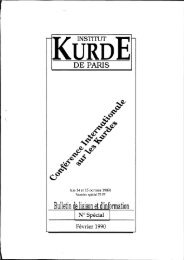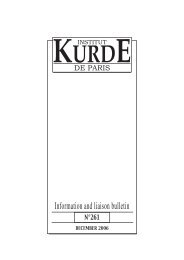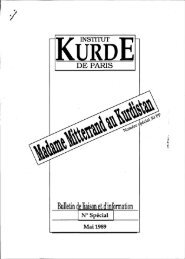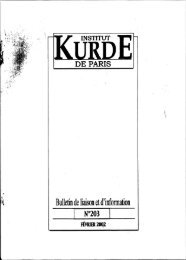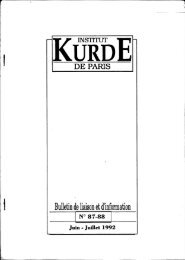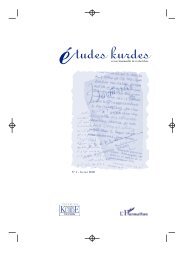Bulletin de liaison et d'information - Institut kurde de Paris
Bulletin de liaison et d'information - Institut kurde de Paris
Bulletin de liaison et d'information - Institut kurde de Paris
You also want an ePaper? Increase the reach of your titles
YUMPU automatically turns print PDFs into web optimized ePapers that Google loves.
Revue <strong>de</strong> Presse-Press Review-Berhevoka Çapê-Rivista Stampa-Dentro<br />
<strong>de</strong> la Prensa-Baszn ()z<strong>et</strong>i<br />
-)<br />
Before 1993 he had not even known the<br />
name of the artist who painted it. Rostam<br />
painstakingly rèproduced<br />
the image and presented<br />
his work. It was rejected<br />
on the pr<strong>et</strong>ext that the<br />
artist was "not a great<br />
master". The painter<br />
whose work Aghala had<br />
copied was Gustav Klimt,<br />
an Austrian (1862-1918)<br />
of the famous "Secessionist<br />
School", who painted the world in its<br />
"feminine appearance".<br />
B<strong>et</strong>ween 1989-1990, Aghala discovered<br />
another discipline: he was called up for the<br />
army. He <strong>de</strong>serted after the Iraqi army was<br />
<strong>de</strong>feated in Kuwait. For three months he<br />
locked himself in a room, and worked on<br />
paintings inspired by the Surrealists. The<br />
three years that followedwere difficult:<br />
Rostam survived by selling books on the<br />
stre<strong>et</strong>s of Baghdad and working in factories...<br />
He was so poor he could not afford<br />
the materials to paine and so <strong>de</strong>pressed that<br />
again he tried to take his own life.<br />
In 1993 his life took a new - happyturn.<br />
An American journalist he m<strong>et</strong> by<br />
chance bought one of his paintings for $400,<br />
a fortune for the impoverished Rostam. The<br />
same journalist also gave him a book about<br />
the work of Gustav Klimt and Rostam dis-.<br />
covered the i<strong>de</strong>ntity of the painter he had<br />
copied, some years before. He also learned<br />
that <strong>de</strong>spite his information to the contrary,<br />
this painter was not an unknown artist, but a<br />
master painter worthy of his admiration and<br />
a credible source of inspiration.<br />
Since becoming a teenager Rostam confesses<br />
to frequently falling in love with girls<br />
- some of whom he did not even speak to<br />
- but in 1995 he m<strong>et</strong> Goulala .and this, he<br />
<strong>de</strong>ci<strong>de</strong>d, was the real thing.<br />
However, Goulala's father, a businessman<br />
from Suleimania, did not want his daughter<br />
involved with "a colourist"j a simple villager<br />
from an unknown family. In <strong>de</strong>spair Rostam<br />
ma<strong>de</strong> plans to leave his homeland for<br />
Europe, like so many young people in Iraqi<br />
Kurdistan. At this point Hero Talabani, the<br />
wife of Jelal Talabani, the powerful PUK<br />
lea<strong>de</strong>r intervened on Rostam's behalf.<br />
Goulalàs father eventually gave in and agreed<br />
the couple could marry.<br />
A new life began for Rostam, he.was in<br />
love and happily married to a beautiful<br />
Many <strong>de</strong>tailsof<br />
Aghala's paintings<br />
reveal intriguing<br />
anomalies that are<br />
wi<strong>de</strong> open to<br />
interpr<strong>et</strong>ation<br />
woman, from an affluene family, who would<br />
became his favourite mo<strong>de</strong>l. But Rostam still<br />
had a problem. Women<br />
are one of the main<br />
themes of his work but he<br />
Qnnotpaintrrommemory,<br />
he needs a mo<strong>de</strong>l,<br />
which raises many problems<br />
in the very traditional<br />
Kurdish soci<strong>et</strong>y. He<br />
loves to paint Goulala,<br />
who was now fully available<br />
as a mo<strong>de</strong>l and appears in many of his<br />
paintings but he nee<strong>de</strong>d other sources of<br />
inspiration in or<strong>de</strong>r to vary his work.<br />
Goulala has a sister whom Rostam also liked<br />
to paine. But he admits that Goulala is quite<br />
jealous and he has problems if he looks for<br />
mo<strong>de</strong>ls outsi<strong>de</strong> the family circle.<br />
The Kurdish elite started buying his<br />
paintings: Jelal and Hero Talabani bought<br />
some of his large paintings to <strong>de</strong>corate their<br />
dining room in Qala Tchwalan. PUK minister<br />
Adnan Mufti bought canvases for his<br />
office and home. But Rostam's clients are<br />
mainly foreigners - the UN and NGO<br />
workers, and the press, and it is a an irregular<br />
clieneele. Rostam's problem is that the<br />
Kurdish people rich enough to buy his<br />
paintings have little esteem for his "folklorist"<br />
and "coulourist" style: "I could just as<br />
weil hang a kilim on my wall", says a<br />
wealthy businessman. Such a comment<br />
reflects a simplistic view of. RosJam's paineings<br />
and a failure to look b~yo'nd their<br />
immediate colourful appearance.<br />
In one of his paintings, Shvan (the Shepherd),<br />
a young woman wears the traditional<br />
dress of the Kurdish shepherd. She is beautiful<br />
but obviously unhappy: two big drops on her<br />
mantle symbolise her tears 3;fidat the same<br />
time ~e womb. On her shoul<strong>de</strong>r two strange<br />
birds are mating upsi<strong>de</strong> down. A butterfly<br />
hovers above her. What does it all mean?<br />
"One day I went to the village of Tak<br />
Tak, near Kay Sinjak", says Rostam, "and I<br />
m<strong>et</strong> a very pr<strong>et</strong>ty woman shepherd: she<br />
could not bear children, so her husband<br />
ma<strong>de</strong> her a shepherd. All the time, while<br />
watching her sheep, she was dreaming of sex<br />
and babies - the butterfly symbolizes her<br />
dreams, and the birds areupsi<strong>de</strong> down<br />
because they Qnnot make love". The story<br />
of this woman does not end here, explains<br />
Rostam: her estranged husband married a<br />
second wife, who was also unable to bear<br />
children. After un<strong>de</strong>rgoing t~ts at the hospital<br />
it was discovered that it was he who<br />
was sterile.<br />
In another painting, Anfa!, a bear<strong>de</strong>d old<br />
man sits in a meadow full of red poppies, with<br />
a young woman, his granddaughter, behind<br />
him, and a steep mountain .in the background.<br />
The old man has lived ,through Anfal<br />
(a terrible campaign against the Kurds in<br />
1988 which claimed 180,000 Victims) and is<br />
recounting his memories to his grand daughter.<br />
"The landsQpe is beautiful", says Rostam.<br />
"But because nature is beautiful does not<br />
mean you have a beautifullife. Our country<br />
was beautiful when Anfal happened and Anfal<br />
could happen again". Many <strong>de</strong>tails of Aghalàs<br />
paineings reveal intriguing anomalies that are<br />
wi<strong>de</strong> open to interpr<strong>et</strong>ation: the meadow is<br />
empty without any sign of grazing Qrue; the<br />
old man's rifle is half hid<strong>de</strong>n behind him. The<br />
pigeons on the tree don't look at each other.<br />
The mountain is bare, without any sign of<br />
shrub or tree. The sky is not blue but red. The<br />
peacock, which towers above the girl and her<br />
grandfather, has no feathers.<br />
So who is the real Rosriun? The happy,<br />
laughing painter with a pal<strong>et</strong>te of luxurious<br />
colours or the bitter unhappy Kurd who<br />
cannot forg<strong>et</strong> his people's pain and the<br />
uncertainty of their <strong>de</strong>stiny? "My life is like<br />
my painting", Rostarn reponds, "I am making<br />
experiences......<br />
TheMiddle East May 2003<br />
59





